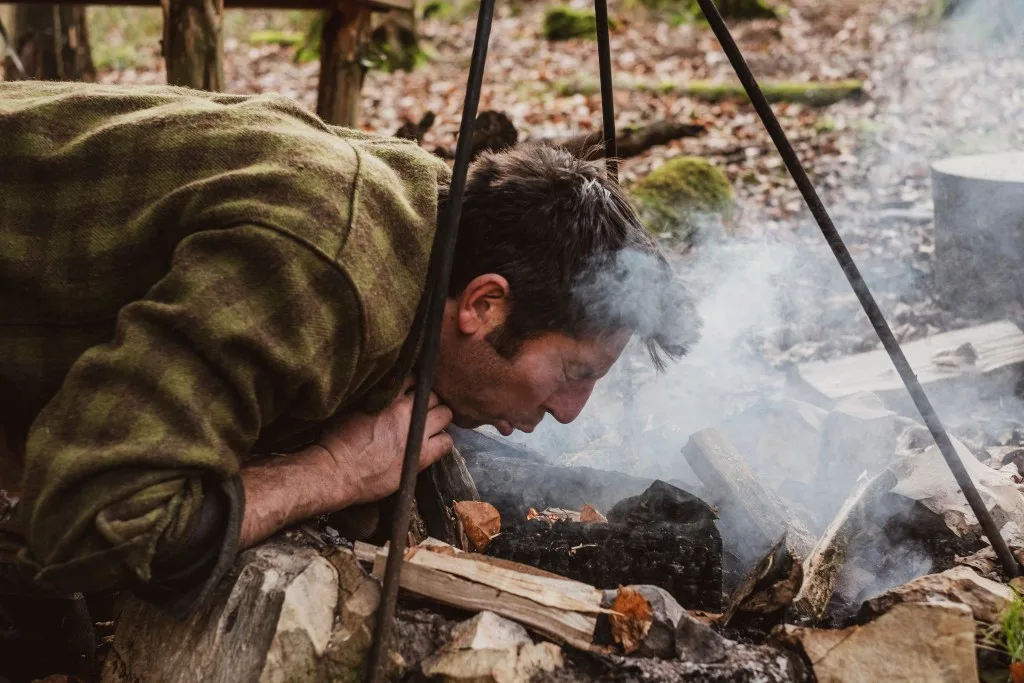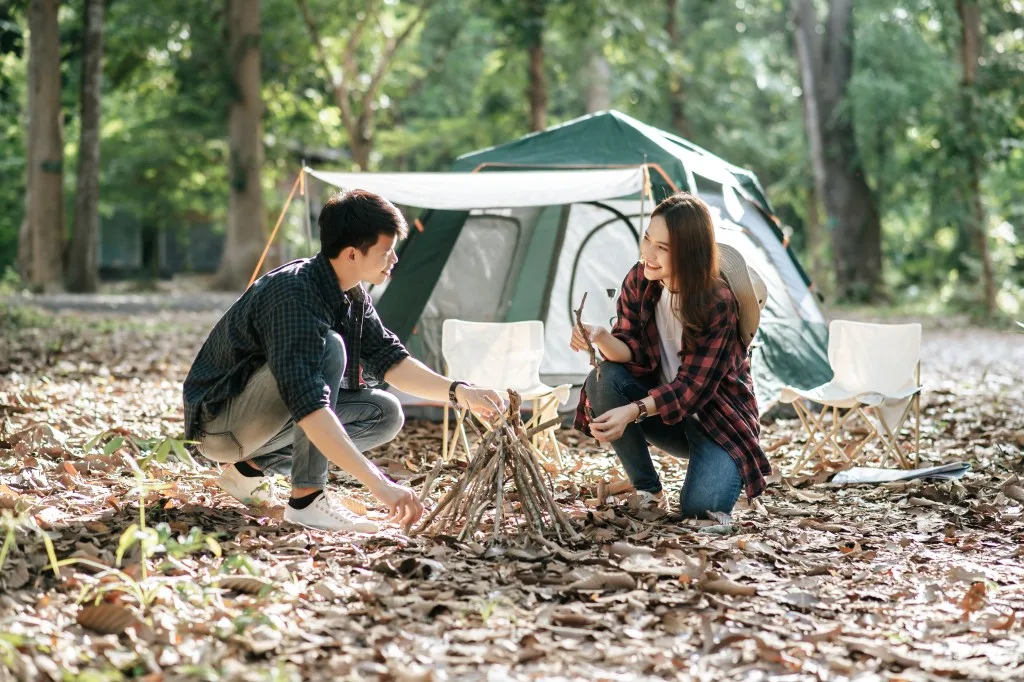Is Burning Cardboard Ok While You’re Camping?
Sometimes, in desperation, we’ll turn to just about anything to get a campfire started, including burning cardboard.
There’s nothing like racing against a setting sun as you struggle to get the fire going. However, is burning cardboard a good option?
Let’s take a look and see if cardboard can fuel your fire!
Why You Shouldn’t Burn Cardboard While You’re Camping
You likely have several cardboard boxes lying around, but you shouldn’t burn them. There are often chemicals and inks in a cardboard box that will release into the air when you burn them. When you’re camping, you might use your campfire for cooking. Cooking your food over burning toxic chemicals isn’t a safe plan.
Burning cardboard can not only be dangerous for your health but also the area around you. A slight breeze can lift a piece of burning cardboard into the air. A flaming piece of cardboard can quickly cause your tiny fire to spread out of control.

What’s the Ecological Effect of Burning Cardboard?
While you may not realize the ecological effect of burning cardboard, you’re releasing toxic chemicals into the air. Most cardboard contains some amount of wax, plastic, ink, paint, or other materials that result in toxic fumes.
Not only are the chemicals going into the air, but the cardboard’s ashes will also contaminate the soil and groundwater. When you pollute the soil and groundwater, that can work its way through the food chain. The crops absorb the contaminants, and then the livestock eats the contaminated crops.
It’s a cycle that ends with humans consuming food that’s a little less pure.
What Should You Do with Your Cardboard Instead of Burning?
Instead of burning your cardboard, you should recycle it. Many garbage services offer to recycle and may include it with your standard service fee. You can also find a recycling center near you to help with your unwanted cardboard.
If you can’t recycle your cardboard, throwing it in the trash is far better than burning it. A piece of cardboard is biodegradable, and so it’ll decompose over time. Tossing the cardboard into the trash will mean it decomposes in a landfill.

What Can You Safely Use to Fuel Your Fire?
The best source to fuel your fire is seasoned and untreated firewood. This type of wood will burn the best and is chemical-free. If you’re camping in a state park or campground, you may need to purchase certified wood. This wood is often heat-treated to ensure no parasites are present to cause damage to the environment.
You may also be able to gather wood from the campground. Look for downed limbs and trees that are dry. Cutting down limbs may seem like a good idea, but they’re full of moisture and will not burn well.
Limbs that have dried out will burn hotter and longer and provide the best fuel for your fire.
Pro Tip: Starting a fire is necessary for a safe and successful camping trip, but learning how to start a campfire can be tricky. Read more to find out How to Build the Perfect Campfire.
Other Things You Shouldn’t Burn While Camping
Not only is burning cardboard a bad idea, but there are several other things you should avoid burning while camping. Let’s take a look!
Plastic
While plastic can be a pain to get rid of, burning it isn’t the answer. Burning plastic can be dangerous for the environment but also you and your fellow campers. Some plastics will release carbon monoxide when burned, which is extremely dangerous.
If you burn plastic to keep your fire going, you may experience headaches, weakness, fatigue, and even damage to your respiratory system. Burning some types of plastics can result in dioxin, which can be transferred from mother to child during pregnancy.

Magazines or Newspapers
While you may have a stack of old magazines or newspapers lying around your house, don’t use them for your next campfire. The color-filled pages likely contain chemicals that can be harmful when burned.
These types of materials often burn very quickly and generate very little heat. This can create a very tall flame, but it won’t last long. Find a better source to provide a long-lasting fire.
Wooden Pallets
While a wooden pallet might seem like a good idea, you have to remember that these are often built from treated wood. Chemicals are often put onto the wood to protect it over time. These chemicals release into the air or your food if you cook over the fire.
Plus, there’s a ton of nails holding them together. This poses a risk for the wildlife and any future campers who drive or step over the nails.
Painted Wood
Burning painted wood can be extremely hazardous to your health. As with cardboard, many harmful chemicals are present in paint, and burning a piece of painted wood releases them into the air.

Poison Ivy, Poison Oak, or Sumac
Did you know that some people don’t have to touch poison ivy, poison oak, or poison sumac in order to have a reaction? Some people are so incredibly allergic to these plants that being in their presence while they burn can cause a serious reaction.
Burning them can often be worse because people can breathe in the fumes. There have been reports of people having reactions in their lungs and respiratory systems due to exposure to these plants while burning.
Trash
While you’re camping, you’ll unavoidably create trash; it’s an inevitable part of living. How you dispose of your trash is completely up to you, but you should be mindful of its impact on the earth and those around you. Burning trash creates air pollution and a less than desirable smell.
Your trash will contain food, cardboard, and plastic, which are either smelly or harmful to the environment.
Pro Tip: Instead of spending time searching for wood to safely build a campfire, start one in seconds with a portable propane fire pit. These are which Portable Propane Fire Pits are Decent, Better, & The Best.
Don’t Burn Cardboard and Leave No Trace
When it comes to camping, we always encourage campers to leave no trace. This includes invisible toxins. You should take only pictures and leave only footprints. And, do your very best to ensure that your campsite is in as good as or better condition than when you arrived.
By doing so, you ensure that others will get to enjoy it as well. Camping is a great way to make memories, and we would love to see many future generations get to enjoy it.
What do you do with your cardboard when you’re camping?
Discover the Best Free Camping Across the USA
To be honest with you, we hate paying for camping. There are so many free campsites in America (with complete privacy).
You should give it a try!
As a matter of fact, these free campsites are yours. Every time you pay federal taxes, you’re contributing to these lands.
Become a FREE CAMPING INSIDER and join the 100,000 campers who love to score the best site!
We’ll send you the 50 Best Free Campsites in the USA (one per state). Access the list by submitting your email below:
Hmmm..better explains why I’m currently fighting cancer after a 35 year career as a firefighter…🥴👨🏻🚒🚒 Dark humor aside, good article..and accurate!
Thank you. Excellent article on dangers of what you burn in your campfire. We all need reminders once in while.
Breathing in the smoke, is enough of a danger, without all they other possible chemicals.
Keep up the great newsletters. I look forward to each new one.